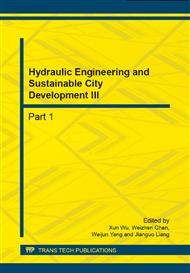[1]
Roland.B. Stull,An introduction to boundary layer meteorology[M], Kluwer Academic Publishers,(1988).
Google Scholar
[2]
Zhang Hongsheng, etc. The observation on the atmospheric boundary layer [J], Meteorology, hydrology and ocean apparatus, No2. (2002).
Google Scholar
[3]
Wang Mingxing, etc., Recent Researches on Aerosol in China[J], Advances in Atmospheric Sciences, 2001, Vol. 18 576~586.
DOI: 10.1007/s00376-001-0046-9
Google Scholar
[4]
Ji Fei, etc. Study on the transformation of gas to particle during the photochemistry process under troposphere layer [J], Chinese Journal of Atmospheric sciences,2001, Vol. 25. No. 2 269~276.
Google Scholar
[5]
Qian Yongpu, Study on the climate effect of PBL aerosol[J], Nan Jing meteorology academy Journal,1994,Vol. 17 No. 2 141~147.
Google Scholar
[6]
YangHui, Liu Wenqing, etc. PBL Observations by Lidar at Peking[J], OPTICAL TECFLNIQUE, 2005, Vo1.3l No.2, 221-226.
Google Scholar
[7]
Fernald, F.G., Analysis of atmospheric lidar observation: some comments [J], Applied. Opt., 1984, 23, 652~655.
DOI: 10.1364/ao.23.000652
Google Scholar
[8]
J.D. Spinhirne, IEEE Transaction on Geoscience and Remote Sensing[J], 1993, 31(1) 48-54.
Google Scholar
[9]
Qin Shiguang, Tang Jie, Wen Yupu, et al. Black Carbon and Its Importance in Climate Change Studies [J]. Meteorological Monthly, 2001, 27(11): 3-7.
Google Scholar
[10]
Novakov T, Andreae M O, Gabriel R, et al. Origin of Carbon acetous aerosol over the Tropical Indian Ocean: Biomass Burning or Fossil Fuels?[J]. Geophysical Research Letters, 2000, 27(24): 4061-4064.
DOI: 10.1029/2000gl011759
Google Scholar
[11]
Lou Shujuan, Mao Jietai, Wang Meihua. Observational study of black carbon aerosol in Beijing [J]. Acta Scientiae Circumstantiae, 2005, 25(1): 17-2.
Google Scholar


